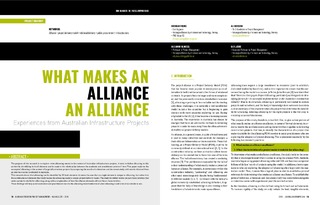| dc.contributor.author | Young, Brendan | |
| dc.contributor.author | Hosseini, Ali | |
| dc.contributor.author | Klakegg, Ole Jonny | |
| dc.contributor.author | Lædre, Ola | |
| dc.date.accessioned | 2019-01-23T15:45:17Z | |
| dc.date.available | 2019-01-23T15:45:17Z | |
| dc.date.created | 2018-06-14T15:20:28Z | |
| dc.date.issued | 2018 | |
| dc.identifier.issn | 2317-3963 | |
| dc.identifier.uri | http://hdl.handle.net/11250/2582019 | |
| dc.description.abstract | This research shows that alliancing can be identified by 25 hard elements. It seems the case that no single element is unique to alliancing, but rather it is the combination of elements that really makes the alliancing model a unique project delivery model. The study identified twelve project characteristics that make a project suitable for alliancing, along with an explanation of how the alliance elements address these characteristics.
These findings will help assist academics and practitioners new to the alliancing model understand what alliancing is and when it is suitable to use. | nb_NO |
| dc.language.iso | eng | nb_NO |
| dc.publisher | Mundo Press | nb_NO |
| dc.title | What Makes an Alliance an Alliance – Experiences from Australian Infrastructure Projects | nb_NO |
| dc.title.alternative | What Makes an Alliance an Alliance – Experiences from Australian Infrastructure Projects | nb_NO |
| dc.type | Journal article | nb_NO |
| dc.type | Peer reviewed | nb_NO |
| dc.description.version | publishedVersion | nb_NO |
| dc.source.volume | 6 | nb_NO |
| dc.source.journal | Journal of Modern Project Management | nb_NO |
| dc.source.issue | 1 | nb_NO |
| dc.identifier.cristin | 1591279 | |
| dc.description.localcode | Copyright © 2018 The Authors. | nb_NO |
| cristin.unitcode | 194,64,91,0 | |
| cristin.unitname | Institutt for bygg- og miljøteknikk | |
| cristin.ispublished | true | |
| cristin.fulltext | original | |
| cristin.qualitycode | 1 | |
